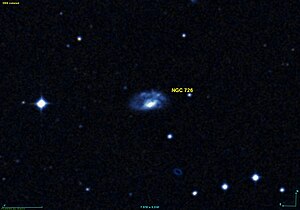NGC 726
| Galaxy NGC 726 |
|
|---|---|

|
|
| AladinLite | |
| Constellation | whale |
|
Position equinox : J2000.0 , epoch : J2000.0 |
|
| Right ascension | 01 h 55 m 31.9 s |
| declination | -10 ° 47 ′ 59 ″ |
| Appearance | |
| Morphological type | SB (s) dm / pec |
| Brightness (visual) | 14.3 mag |
| Brightness (B-band) | 14.9 mag |
| Angular expansion | 1.2 ′ × 0.6 ′ |
| Position angle | 100 ° |
| Surface brightness | 13.8 mag / arcmin² |
| Physical data | |
| Redshift | 0.017879 +/- 0.000033 |
| Radial velocity | 5360 +/- 10 km / s |
|
Stroke distance v rad / H 0 |
(240 ± 17) x 10 6 ly (73.5 ± 5.1) Mpc |
| history | |
| discovery | Frank Muller |
| Discovery date | 1886 |
| Catalog names | |
| NGC 726 • PGC 7182 • MCG -02-06-03 • IRAS F01531-1102 • KUG 153-110 • 2MASX J01553187-1047591 • KUG 0153-110 | |
NGC 726 is a barred spiral galaxy of the Hubble type SBdm in the constellation Whale south of the celestial equator . It is estimated to be 240 million light-years from the Milky Way and about 85,000 light years in diameter.
The object was discovered in 1886 by the American astronomer Frank Muller .
Web links
- SIMBAD Astronomical Database
- Auke Slotegraaf: NGC 726. Deep Sky Observer's Companion, accessed November 7, 2015 .
